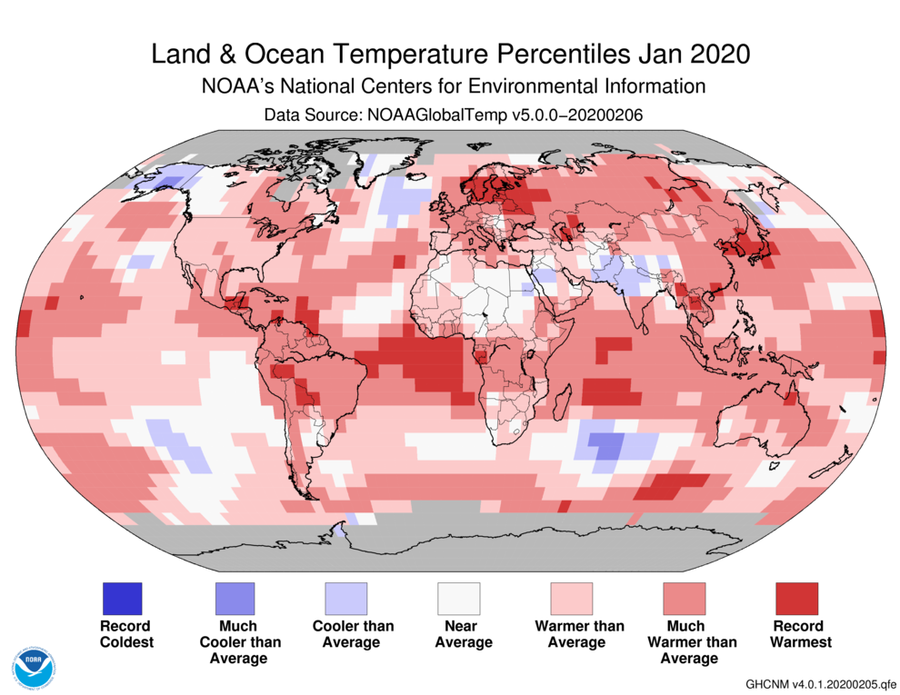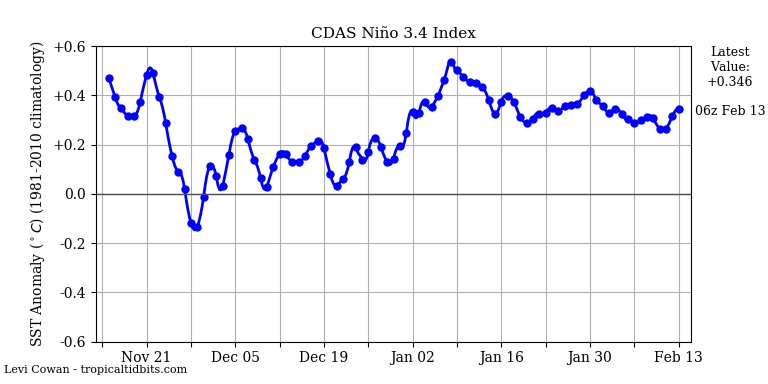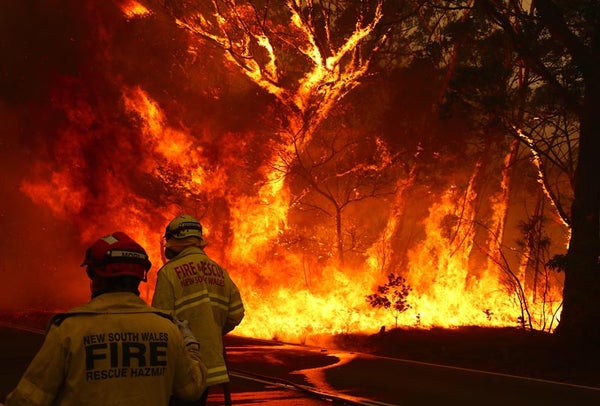This article was published in Scientific American’s former blog network and reflects the views of the author, not necessarily those of Scientific American
January 2020 was the planet's warmest January since record keeping began in 1880, said NOAA's National Centers for Environmental Information (NCEI) on Thursday. Global ocean temperatures during January 2020 were the second warmest on record, and global land temperatures were the warmest on record. Global satellite-measured temperatures in January 2020 for the lowest 8 km of the atmosphere were the warmest or second warmest in the 42-year record, according to the University of Alabama Huntsville (UAH) and RSS, respectively.
January 2020 had the fourth highest departure of temperature from average of any month since 1880. Only March 2016, February 2016 and December 2015 had a greater temperature departure. Impressively, the warmth of January 2020 came without an El Niño event being present. Furthermore, we are also near the nadir of one of the least active solar cycles in the past century--a time when it is more difficult to set global heat records, due to the reduced amount of solar energy Earth receives. Thus, the remarkable warmth of January 2020 is a strong reminder that human-caused global warming is the primary driver of our warming climate.

Figure 1. Departure of temperature from average for January 2020, the warmest January for the globe since record keeping began in 1880. Record warm January surface temperatures were present across parts of Scandinavia, Asia, the Indian Ocean, the central and western Pacific Ocean, the Atlantic Ocean, and Central and South America. No land or ocean areas had record cold January temperatures. Credit: NOAA National Centers for Environmental Information (NCEI)
On supporting science journalism
If you're enjoying this article, consider supporting our award-winning journalism by subscribing. By purchasing a subscription you are helping to ensure the future of impactful stories about the discoveries and ideas shaping our world today.
Two billion-dollar weather disasters in January 2020
Two billion-dollar weather-related disaster hit the Earth last month, according to the January 2020 Catastrophe Report from insurance broker Aon:
U.S. severe weather outbreak: A powerful winter storm over central and eastern sections of the U.S. from January 10 - 12 killed 12 and did $1.2 billion in damage. The storm brought a multi-day severe weather outbreak to parts of Texas, Oklahoma, Missouri, Arkansas, Louisiana, Mississippi, Alabama, Tennessee, Kentucky and Georgia, with 79 confirmed tornadoes.
Australia wildfires: Intense heat and drought over much of Australia in January caused destructive wildfires blamed for billions of dollars in damages. The combined death toll for the 2019/20 Australia bushfire season stands at 34, with more than 5,900 homes and other structures destroyed. Guardian Australia has launched the first of six very impressive immersive multimedia features on climate change, reported through the experiences of people living through it in Australia. The first episode--on bushfires--is best viewed on a large screen (not mobile) with the sound on. Also, Peter Sinclair of the Yale Climate Forum has put together an excellent video on the Australian fires and their climate change connection.
Neutral El Niño conditions reign
NOAA’s February 13 monthly discussion of the state of the El Niño/Southern Oscillation (ENSO) stated that neutral ENSO conditions existed, with neither an El Niño nor a La Niña event in progress. Over the past month, sea surface temperatures (SSTs) in the benchmark Niño3.4 region of the eastern tropical Pacific, though warmer than average, have been below the 0.5°C above-average threshold need to be considered El Niño conditions.
Forecasters at NOAA and the International Research Institute for Climate and Society (IRI) are calling for a roughly 60% chance of neutral conditions continuing through Northern Hemisphere spring, and a 50% chance of continuing through summer. They put the odds of an El Niño event during the August-September-October peak of the hurricane season at 23%, and the odds of a La Niña event during that period at 33%.

Figure 2. Departure of sea surface temperatures (SSTs) in the benchmark Niño 3.4 region (in the equatorial Pacific) ending on February 13, 2020. Over the past month, SSTs were about 0.3°C above average, falling short of the 0.5°C above-average threshold need to be considered El Niño conditions. Credit: Levi Cowan tropicaltidbits.com
Arctic sea ice: eighth lowest January extent on record
Arctic sea ice extent during January 2020 was tied for eighth lowest in the 41-year satellite record, according to the National Snow and Ice Data Center (NSIDC). The ice extent was higher than seen in recent years thanks to a strongly positive phase of the Arctic Oscillation (AO), which kept cold air bottled up in the Arctic. Antarctic sea ice extent in January 2020 was the tenth lowest on record.
Notable global heat and cold marks for January 2020
Hottest temperature in the Northern Hemisphere: 42.0°C (107.6°F) at Vicente Guerrero, Mexico, 21 January
Coldest temperature in the Northern Hemisphere: -66.0°C (-86.8°F) at Geo Summit, Greenland, 3 January (dubious data)
Hottest temperature in the Southern Hemisphere: 48.9°C (120.0°F) at Penrith, Australia, 4 January
Coldest temperature in the Southern Hemisphere: -47.4°C (-53.3°F) at Concordia, Antarctica, 31 January
(Courtesy of Maximiliano Herrera.)
Major weather stations that set (not tied) new all-time heat or cold records in January 2020
Among global stations with a period of record of at least 40 years, 28 set new all-time heat records in January, and 3 set all-time cold records:
Canberra (Australia) max. 44.0°C, 4 January
Newcastle (Australia) max. 44.9°C, 4 January
Katoomba (Australia) max. 39.8°C, 4 January
Parramatta (Australia) max. 47.0°C, 4 January
Bankstown (Australia) max. 47.0 °C, 4 January
Taralga (Australia) max. 40.5°C, 4 January
Goulburn Airport (Australia) max. 42.0°C, 4 January
Albury (Australia) max. 46.1°C, 4 January
Burrinjuck Dam (Australia) max. 45.0°C, 4 January
Grenfell (Australia) max. 44.0°C, 4 January
Young (Australia) max. 44.9°C, 4 January
Gundagai (Australia) max. 45.2°C, 4 January
Cootamundra (Australia) max. 45.0°C, 4 January
Temora (Australia) max. 46.4°C, 4 January
Narrandera (Australia) max. 47.4°C, 4 January
Griffith (Australia) max. 47.2°C, 4 January
Calama (Chile) max. 31.2 °C, 12 January
Fraserburg (South Africa) max. 42.4°C, 16 January
Pofadder (South Africa) max. 43.0°C, 16 January
Willowmore (South Africa) max. 42.2°C, 16 January
Beaufort West (South Africa) max. 44.5°C, 16 January
Saint Raphael-Cargados Islands (Mauritius) max. 35.6°C, 9 January
Honiara Downtown (Solomon Islands) max. 35.4°C, 3 January
Veguitas (Cuba) min. 7.0 °C, 23 January
Pinares de Mayari (Cuba) min. 6.5°C, 23 January
Conakry Airport (Guinea) max. 38.0°C, 24 January
Kalewa (Myanmar) min. 6.6°C, 26 January
Cabramurra (Australia) max. 34.0°C, 31 January
Hobart Airport (Australia) max. 41.4°C, 31 January
Maydena (Australia) max. 38.2°C, 31 January
Gisborne (New Zealand) max. 38.2°C, 31 January
No all-time national heat or cold records have been set thus far in 2020.
(Courtesy of Maximiliano Herrera.)
Fourteen monthly national/territorial heat record beaten or tied in 2020 as of February 17
As of February 17, 14 national monthly all-time heat records have been beaten or tied in 2020:
January (10): Norway, South Korea, Angola, Congo Brazzaville, Dominica, Mexico, Indonesia, Guinea Bissau, Gambia, Sao Tome and Principe
February (4): Spain, Antarctica, Azerbaijan, Costa Rica
No monthly national cold records have been beaten or tied in 2020.
(Courtesy of Maximiliano Herrera.)
Hemispherical and continental temperature records in 2020
Highest minimum temperature ever recorded the Northern Hemisphere in January: 29.1°C (84.4°F) at Bonriki, Kiribati, 17 January.
Highest maximum temperature ever recorded in North America in January: 42.0°C (107.6°F) at Vicente Guerrero, Mexico, 21 January.
Highest temperature ever recorded in continental Antarctica and highest February temperature ever recorded in Antarctica plus the surrounding islands: 18.4°C (65.1°F) at Base Esperanza, 6 February.
(Courtesy of Maximiliano Herrera.)
